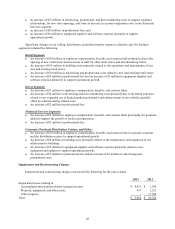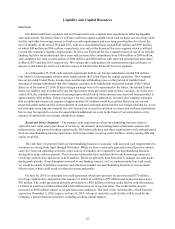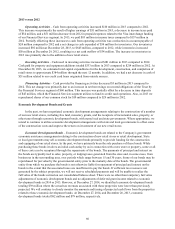Cabela's 2014 Annual Report Download - page 62
Download and view the complete annual report
Please find page 62 of the 2014 Cabela's annual report below. You can navigate through the pages in the report by either clicking on the pages listed below, or by using the keyword search tool below to find specific information within the annual report.
52
Interest (Expense) Income, Net
Interest expense, net of interest income, increased $2 million to $22 million in 2013 compared to $20 million
in 2012. Interest expense is accrued on our revolving credit facilities and long-term debt as well as on unrecognized
tax benefits.
Other Non-Operating Income, Net
Other non-operating income was $4 million for 2013 and $6 million for 2012. This income was primarily
from interest earned on our economic development bonds.
Provision for Income Taxes
Our effective tax rate was 34.7% in 2013 compared to 33.7% in 2012. The effective tax rates for both
years differed from our statutory rate primarily due to the mix of taxable income between the United States
and foreign tax jurisdictions. The balance of unrecognized tax benefits, which was classified with long-term
liabilities in the consolidated balance sheet, totaled $65 million at December 28, 2013, compared to $39 million
at December 29, 2012.
Asset Quality of Cabela’s CLUB
Delinquencies and Non-Accrual
We consider the entire balance of an account, including any accrued interest and fees, delinquent if the
minimum payment is not received by the payment due date. Our aging method is based on the number of
completed billing cycles during which a customer has failed to make a required payment. As part of collection
efforts, a credit card loan may be closed and placed on non-accrual or restructured in a fixed payment plan prior to
charge off. Our fixed payment plans require payment of the loan within 60 months and consist of a lower interest
rate, reduced minimum payment, and elimination of fees. Loans on fixed payment plans include loans in which
the customer has engaged a consumer credit counseling agency to assist them in managing their debt. Customers
who miss two consecutive payments once placed on a payment plan or non-accrual will resume accruing interest
at the rate they had accrued at before they were placed on a plan. Interest and fees are accrued in accordance with
the terms of the applicable cardholder agreements or payment plan on credit card loans until the date of charge-off
unless placed on non-accrual. Payments received on non-accrual loans will be applied to principal and reduce the
amount of the loan.
The quality of our credit card loan portfolio at any time reflects, among other factors: 1) the creditworthiness
of cardholders, 2) general economic conditions, 3) the success of our account management and collection activities,
and 4) the life-cycle stage of the portfolio. During periods of economic weakness, delinquencies and net charge-
offs are more likely to increase. We have mitigated periods of economic weakness by selecting a customer base
that is very creditworthy. We use the scores of Fair Isaac Corporation (“FICO”), a widely-used financial metric for
assessing an individual’s credit rating, as the primary credit quality indicator. The median FICO score of our credit
cardholders was 795 at the end of 2014 and 793 at the end of 2013.
The following table reports delinquencies, including any delinquent non-accrual and restructured credit card
loans, as a percentage of our credit card loans, including any accrued interest and fees, in a manner consistent with
our monthly external reporting for the years ended:
2014 2013 2012
Number of days delinquent:
Greater than 30 days 0.68% 0.69% 0.72%
Greater than 60 days 0.41 0.42 0.46
Greater than 90 days 0.22 0.22 0.24
























